Mary Cronk Farrell's Blog, page 14
May 8, 2015
A Day with Bright Young Minds Can Really Fire You Up
Look at the enthusiasm of these students!
 They earned a field trip and pizza party for meeting their reading goals over the school year. One young girl more than doubled hers. I knew we were kindred spirits as soon as I heard two kids confess they read when they were supposed to be doing their chores.
They earned a field trip and pizza party for meeting their reading goals over the school year. One young girl more than doubled hers. I knew we were kindred spirits as soon as I heard two kids confess they read when they were supposed to be doing their chores.I had the privilege and delight of talking to them about writing, and sharing the topics of my books. Their many questions revealed their curiosity and eagerness to learn. I was impressed by their level of knowledge, which, of course, I attribute to the fact they are all terrific readers. But they attend a unique school, as well.

Examining historical photos of miners in the Coeur d'Alene Silver Mining District, the students drew inferences about conditions of the time and place.
At left: The original Old Glory Hole at the Bunker & Sullivan Mine, Kellogg, ID.
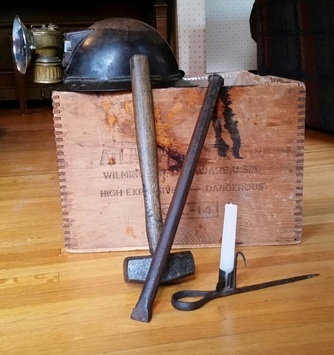
These museum quality artifacts I collected while researching Fire in the Hole! help students gain hands-on experience of the time period.
Below students take a turn with hammer and steel to get a feel for how hard miners' worked in the old days before power drills.
 These students attend the Continuous Curriculum School in the East Valley School District near Spokane, WA. They explained to me how they only get six weeks off for the summer, but get more breaks during the rest of the school year.
These students attend the Continuous Curriculum School in the East Valley School District near Spokane, WA. They explained to me how they only get six weeks off for the summer, but get more breaks during the rest of the school year. My favorite part of visiting with students this week was hearing about the characters they developed during a short writing assignment. One character was a 6-year-old girl named Hannah, with neon-hair and freckles. Her goal was to pan for fools' gold, and to meet it, she had to climb a mountain and brave a river full of alligators. Now that's a story I want to read!
It was a terrific break from writing to spend a couple hours with these bright, curious and confident young people. It was inspiring how they shared their ideas with such eagerness and enthusiasm. Several weeks ago, I met with a book club of mostly retired women, and is was similarly invigorating. Their life experiences and wisdom felt like a book I'd love to page through.
Let's hear from you! What do you gain from spending time with people outside your own age group.
Published on May 08, 2015 17:22
April 23, 2015
Choosing to Live Your Limitations with Joy
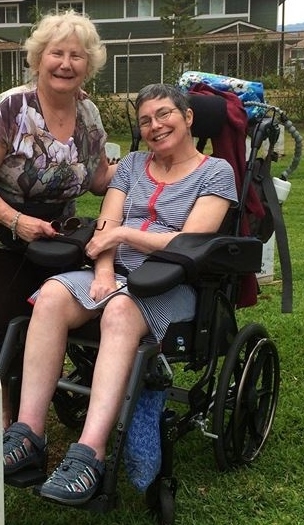 Jeanne & her mother AngelaMy sister-in-law Jeanne does not think of herself as particularly brave or inspirational. Those qualities seem to be in the eye of the beholder.
Jeanne & her mother AngelaMy sister-in-law Jeanne does not think of herself as particularly brave or inspirational. Those qualities seem to be in the eye of the beholder.Jeanne lives with the chronic illness Multiple Sclerosis, which has gradually diminished her physical abilities. From the neck down, her body pretty much ignores all commands.
"It's not sad or disabling," she says. "It's just me. People might think, 'Oh, that’s terrible she can’t do this or that' but I think it just depends on your perspective."
As long as I've known Jeanne, she's always been up for the next activity, jumping at the chance to do something new, or finding any excuse to have a party. She's positive and enthusiastic.
Her out-going personality is a plus when she notices people are uncomfortable about her wheelchair. "I try to make them feel at ease by smiling and talking. When kids stare at my wheels, I say, 'Yes! It's really fun.' and tell them I love my sippy cup."
 Hands-free water bottle and earphones Jeanne uses to make calls or answer the phone."I bite the button because I can't press it with my thumb. If you get it it on the flat surface of your tooth it works great
,
" she says.
Hands-free water bottle and earphones Jeanne uses to make calls or answer the phone."I bite the button because I can't press it with my thumb. If you get it it on the flat surface of your tooth it works great
,
" she says.It's no fun to have MS, and annoying when you can't scratch your nose when it itches, but Jeanne is intentional about enjoying everything she can do.
"You can decide to go on about your life, choose to do things, rather than just sit home. You can make jokes about it, and have family and friends who you trust who you can talk to."
You have to choose, do you want to be miserable, or do you want to be happy.Jeanne enjoys listening to music and podcasts. She can’t read because she's lost her eyesight, but feels it's important to keep learning. She and her husband love to travel.
 “We drive in the car, because the airline is difficult, although we just went to Hawaii. We drive all over the United States, you really enjoy the country driving it on the back roads, and stopping different places, eating the foods in different areas. ‘Course we drink beer.”
“We drive in the car, because the airline is difficult, although we just went to Hawaii. We drive all over the United States, you really enjoy the country driving it on the back roads, and stopping different places, eating the foods in different areas. ‘Course we drink beer.” At left, Jeanne and Bob enjoy the Abyss release party at the Deschutes Public House in Portland, Oregon. In the next month or two they will travel from their home in Western Washington to Florida to visit a friend, Alabama for a wedding, and Colorado for their daughter's graduation from nursing school.
Bob is Jeanne's primary care-giver, chauffeur, housekeeper, cook, gardener, etc. He does all those little things for her that you and I use our hands to do for ourselves on a daily basis.
Jeanne says there are some advantages to not being physically able. "Some people might worry about their hair or something, I can’t even see my hair. There's less to worry about. It sounds funny, but MS is a blessing in disguise because you have to be positive, otherwise, you’d be a miserable person, and then you might as well just go check yourself into the mortuary."
"It's not Pollyanna,What is MS?
and it's not denial.
It’s acceptance."
Multiple sclerosis (MS) is an unpredictable, often disabling disease of the central nervous system that disrupts the flow of information within the brain, and between the brain and body.
The cause of MS is still unknown – scientists believe the disease is triggered by as-yet-unidentified environmental factor(s) in a person who is genetically predisposed to respond. There is no cure.
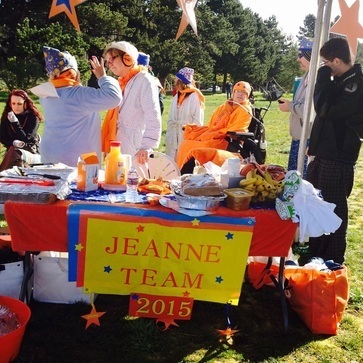 Friends and family gathered recently for Walk MS to raise money for MS research and support services for people living with MS. Jeanne's team slogan is:
Putting MS to Sleep Permanently.
And yes, we did wear our pajamas. The event is lots of fun.
Friends and family gathered recently for Walk MS to raise money for MS research and support services for people living with MS. Jeanne's team slogan is:
Putting MS to Sleep Permanently.
And yes, we did wear our pajamas. The event is lots of fun.I enjoy writing about brave people from way back in history. But sometimes the best inspiration comes from the courageous people close to us.
What about you? Do you have someone in your life who inspires you? Share in the comment section below.
Published on April 23, 2015 08:21
April 16, 2015
Comparing Economics: Fannie's Time vs Our Time
Whoo-hoo! Sent final edits and photographs off to my editor my upcoming book, a biography on Labor Organizer Fannie Sellins. But a writer's work is never done.
I've been doing more research on the project, as I look ahead to promoting the book when it comes next year.
The past couple days I've researching poverty in America, and decided to share with you some of what I've found.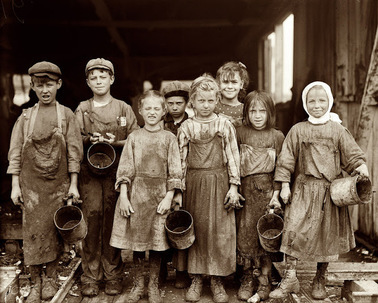 At the Maggioni Canning Company in Port Royal, South Carolina, children shucked oysters for 4 hours before a half day of school, returning for 3 more hours of work after school. Fannie lived in the early 1900’s, often called the Gilded Age of American Industrialization. Steel, coal and railroad magnates wore diamonds and lived in mansions. Their workers wore rags and lived in primitive conditions.
At the Maggioni Canning Company in Port Royal, South Carolina, children shucked oysters for 4 hours before a half day of school, returning for 3 more hours of work after school. Fannie lived in the early 1900’s, often called the Gilded Age of American Industrialization. Steel, coal and railroad magnates wore diamonds and lived in mansions. Their workers wore rags and lived in primitive conditions.
Today American children live in a new Gilded Age where a corporate executive can drop $100 on a single restaurant meal, while a single mother cannot afford meat for her children.
The latest United States census report shows one out of seven Americans live below the poverty line.
The number of children in poverty is higher yet. UNICEF reports that since the start of the global recession in 2008, that number has increased in the United States by 32%. Since the recession has leveled off, the number has not dropped.
The National Center for Law and Economic Justice Inc. reports that close to 23% of American children (age 0-18) are poverty-stricken as measured by the U.S. census.
 Image courtesy Save the Children With the exception of Romania, no developed country has a higher percentage of kids in poverty than America, according to the United Nations Children’s Fund (UNCF).
Image courtesy Save the Children With the exception of Romania, no developed country has a higher percentage of kids in poverty than America, according to the United Nations Children’s Fund (UNCF).
An article in Forbes Magazine disputes these stats on child poverty. Forbes, a leading source of news for American business and financial people in this country, published the assertion that the statistics were unfairly twisted to suggest the level of poverty in the U.S. is higher than is true.
However, the Organization for Economic Co-operation and Development (OECD) reports that the number of poor kids (age 0-17) in the U.S. exceeds 20%. The OECD is an international economic organization of 34 countries founded in 1961 to stimulate economic progress and world trade.
There will always be disagreement and debate about how to handle the issue of poverty. But while the posturing continues and the arguments fly, it is the innocent and helpless who suffer. The largest group of impoverished children are age 0-3.
Our children thirst for hope. They hunger for compassion, and for leaders like Fannie to stand up for them. Whether one agrees with her methods or not, Fannie Sellins put her principles and all her resources into action. She did not relent in her efforts to help the poor, even when her life was at risk.
I've been doing more research on the project, as I look ahead to promoting the book when it comes next year.
The past couple days I've researching poverty in America, and decided to share with you some of what I've found.
 At the Maggioni Canning Company in Port Royal, South Carolina, children shucked oysters for 4 hours before a half day of school, returning for 3 more hours of work after school. Fannie lived in the early 1900’s, often called the Gilded Age of American Industrialization. Steel, coal and railroad magnates wore diamonds and lived in mansions. Their workers wore rags and lived in primitive conditions.
At the Maggioni Canning Company in Port Royal, South Carolina, children shucked oysters for 4 hours before a half day of school, returning for 3 more hours of work after school. Fannie lived in the early 1900’s, often called the Gilded Age of American Industrialization. Steel, coal and railroad magnates wore diamonds and lived in mansions. Their workers wore rags and lived in primitive conditions. Today American children live in a new Gilded Age where a corporate executive can drop $100 on a single restaurant meal, while a single mother cannot afford meat for her children.
The latest United States census report shows one out of seven Americans live below the poverty line.
The number of children in poverty is higher yet. UNICEF reports that since the start of the global recession in 2008, that number has increased in the United States by 32%. Since the recession has leveled off, the number has not dropped.
The National Center for Law and Economic Justice Inc. reports that close to 23% of American children (age 0-18) are poverty-stricken as measured by the U.S. census.
 Image courtesy Save the Children With the exception of Romania, no developed country has a higher percentage of kids in poverty than America, according to the United Nations Children’s Fund (UNCF).
Image courtesy Save the Children With the exception of Romania, no developed country has a higher percentage of kids in poverty than America, according to the United Nations Children’s Fund (UNCF).An article in Forbes Magazine disputes these stats on child poverty. Forbes, a leading source of news for American business and financial people in this country, published the assertion that the statistics were unfairly twisted to suggest the level of poverty in the U.S. is higher than is true.
However, the Organization for Economic Co-operation and Development (OECD) reports that the number of poor kids (age 0-17) in the U.S. exceeds 20%. The OECD is an international economic organization of 34 countries founded in 1961 to stimulate economic progress and world trade.
There will always be disagreement and debate about how to handle the issue of poverty. But while the posturing continues and the arguments fly, it is the innocent and helpless who suffer. The largest group of impoverished children are age 0-3.
Our children thirst for hope. They hunger for compassion, and for leaders like Fannie to stand up for them. Whether one agrees with her methods or not, Fannie Sellins put her principles and all her resources into action. She did not relent in her efforts to help the poor, even when her life was at risk.
Published on April 16, 2015 20:22
April 10, 2015
Army Nurse Tells of Her Escape from Bataan
Not many folks left who remember April 9th as
The
Fall of Bataan,
the day American forces surrendered to an enemy in battle. A surrender that demanded unimaginable courage from the men who survived the death march and hell ships that followed.
American nurses escaped Bataan as the Japanese closed in. I couldn't share all the nurses' stories in my book Pure Grit. Here's one I had to leave out--from Army Nurse Bertha Dworsky. Army Nurse Bertha Dworsky Henderson at home in Texas after the liberation of Santo Tomas Internment Camp in March 1945. Photo courtesy of University of North Texas Libraries, The Portal to Texas History Bataan is a small peninsula forming the western border of Manila Bay in the Philippine Islands, no more than 15 miles wide at the last battle line in April 1942. Imagine the night, a cacophony of gunfire, artillery shells and the cries of the wounded.
Army Nurse Bertha Dworsky Henderson at home in Texas after the liberation of Santo Tomas Internment Camp in March 1945. Photo courtesy of University of North Texas Libraries, The Portal to Texas History Bataan is a small peninsula forming the western border of Manila Bay in the Philippine Islands, no more than 15 miles wide at the last battle line in April 1942. Imagine the night, a cacophony of gunfire, artillery shells and the cries of the wounded.
The decision had been made to surrender the following morning. General Jonathan Wainwright could not allow American women to fall into the hands of the Japanese Army.
Army Nurse Bertha Dworsky had been on duty in the underground tunnel hospital on Corregidor Island throughout the three-month battle. She was ordered to Bataan April 6, 1942.
“They were having so many casualties on Bataan that they wanted more help over there. When I got there, as little as I remember about it, I was pretty much in a daze. It was such a contrast to the clean (sort of) little bit of a secure feeling we had at The Rock. Even though we were bombed the bombs could not penetrate the rock and we were safe as long as we were underneath [in the tunnel]. Bataan Jungle, circa 1942, Courtesy U.S. Army Signal Corps "But, in Bataan you were out in the jungles. No buildings or anything…All we could do was to clear out a little more underbrush under trees and toss the blanket on the ground and put more patients allover.
Bataan Jungle, circa 1942, Courtesy U.S. Army Signal Corps "But, in Bataan you were out in the jungles. No buildings or anything…All we could do was to clear out a little more underbrush under trees and toss the blanket on the ground and put more patients allover.
We couldn't bathe them or anything. All we could do was try to give them a little medicine or a little food. I was just pretty much in a state of shock at the conditions at the time.
Nurse Bertha Dworksy had been on Bataan only two days when she got new orders. "Josephine Nesbitt Davis, she was the Chief Nurse, she told us to all pack our little suitcases; that we were being evacuated. This was late at night. So they loaded school buses and whatever vehicles they possibly could and started toward Marivales, toward the Coast. In the meantime, in the middle of the night, our own forces decided to blow up the ammunition dump. So we were kept up there for hours with the holocaust all around us. At first we didn't know what was going on until someone said, 'We're blowing up our own ammunition because the enemy is close by.'
In the meantime, they told us that Japanese snipers were in the trees all around the hospitals and various other places. We finally got through and reached the dock of Marivales early that morning.
 Underground Hospital in Malinta Tunnel, Corregidor before WWII, U.S. Army Signal Corps "Well, by that time, there were no boats there to meet us. But while we were waiting the Japanese bombers came over to bomb early in the morning. So we quickly dashed into the ditches, tried to protect ourselves.
Underground Hospital in Malinta Tunnel, Corregidor before WWII, U.S. Army Signal Corps "Well, by that time, there were no boats there to meet us. But while we were waiting the Japanese bombers came over to bomb early in the morning. So we quickly dashed into the ditches, tried to protect ourselves.
Eventually, the bombing cleared and some boat came over and we piled onto it and we were on our way to Corregidor. It was, I think, a three mile water crossing between Corregidor and Marivales. As we were trying to land at Corregidor, the bombers
came again.
I recall so plainly that the bombs fell all around us and as they hit the water, it was just like a huge geyser coming up. Spouts all over from the bombs. But they didn't hit us. Eventually, the Japanese bombers left we went ashore and into The Rock.
Bertha shared her memories of her escape from Bataan April 9, 1983 when the POW nurses were honored by President Ronald Reagan at a White House ceremony. Thirty-one of the 67 Army and Navy nurses who had been captured by the Japanese in 1942 were alive and well enough to be there. For more on that story see the most recent post Norm Haskett's blog The Daily Chronicles of WWII.
Photo above of Army Nurse Bertha Dworsky Henderson courtesy: The Caldwell News and The Burleson County Ledger (Caldwell, Tex.), Vol. 58, No. 40, Ed. 1 Friday, April 13, 1945, Newspaper, April 13, 1945; accessed April 10, 2015), University of North Texas Libraries, The Portal to Texas History, crediting Harrie P. Woodson Library, Caldwell, Texas.
American nurses escaped Bataan as the Japanese closed in. I couldn't share all the nurses' stories in my book Pure Grit. Here's one I had to leave out--from Army Nurse Bertha Dworsky.
 Army Nurse Bertha Dworsky Henderson at home in Texas after the liberation of Santo Tomas Internment Camp in March 1945. Photo courtesy of University of North Texas Libraries, The Portal to Texas History Bataan is a small peninsula forming the western border of Manila Bay in the Philippine Islands, no more than 15 miles wide at the last battle line in April 1942. Imagine the night, a cacophony of gunfire, artillery shells and the cries of the wounded.
Army Nurse Bertha Dworsky Henderson at home in Texas after the liberation of Santo Tomas Internment Camp in March 1945. Photo courtesy of University of North Texas Libraries, The Portal to Texas History Bataan is a small peninsula forming the western border of Manila Bay in the Philippine Islands, no more than 15 miles wide at the last battle line in April 1942. Imagine the night, a cacophony of gunfire, artillery shells and the cries of the wounded.The decision had been made to surrender the following morning. General Jonathan Wainwright could not allow American women to fall into the hands of the Japanese Army.
Army Nurse Bertha Dworsky had been on duty in the underground tunnel hospital on Corregidor Island throughout the three-month battle. She was ordered to Bataan April 6, 1942.
“They were having so many casualties on Bataan that they wanted more help over there. When I got there, as little as I remember about it, I was pretty much in a daze. It was such a contrast to the clean (sort of) little bit of a secure feeling we had at The Rock. Even though we were bombed the bombs could not penetrate the rock and we were safe as long as we were underneath [in the tunnel].
 Bataan Jungle, circa 1942, Courtesy U.S. Army Signal Corps "But, in Bataan you were out in the jungles. No buildings or anything…All we could do was to clear out a little more underbrush under trees and toss the blanket on the ground and put more patients allover.
Bataan Jungle, circa 1942, Courtesy U.S. Army Signal Corps "But, in Bataan you were out in the jungles. No buildings or anything…All we could do was to clear out a little more underbrush under trees and toss the blanket on the ground and put more patients allover. We couldn't bathe them or anything. All we could do was try to give them a little medicine or a little food. I was just pretty much in a state of shock at the conditions at the time.
Nurse Bertha Dworksy had been on Bataan only two days when she got new orders. "Josephine Nesbitt Davis, she was the Chief Nurse, she told us to all pack our little suitcases; that we were being evacuated. This was late at night. So they loaded school buses and whatever vehicles they possibly could and started toward Marivales, toward the Coast. In the meantime, in the middle of the night, our own forces decided to blow up the ammunition dump. So we were kept up there for hours with the holocaust all around us. At first we didn't know what was going on until someone said, 'We're blowing up our own ammunition because the enemy is close by.'
In the meantime, they told us that Japanese snipers were in the trees all around the hospitals and various other places. We finally got through and reached the dock of Marivales early that morning.
 Underground Hospital in Malinta Tunnel, Corregidor before WWII, U.S. Army Signal Corps "Well, by that time, there were no boats there to meet us. But while we were waiting the Japanese bombers came over to bomb early in the morning. So we quickly dashed into the ditches, tried to protect ourselves.
Underground Hospital in Malinta Tunnel, Corregidor before WWII, U.S. Army Signal Corps "Well, by that time, there were no boats there to meet us. But while we were waiting the Japanese bombers came over to bomb early in the morning. So we quickly dashed into the ditches, tried to protect ourselves. Eventually, the bombing cleared and some boat came over and we piled onto it and we were on our way to Corregidor. It was, I think, a three mile water crossing between Corregidor and Marivales. As we were trying to land at Corregidor, the bombers
came again.
I recall so plainly that the bombs fell all around us and as they hit the water, it was just like a huge geyser coming up. Spouts all over from the bombs. But they didn't hit us. Eventually, the Japanese bombers left we went ashore and into The Rock.
Bertha shared her memories of her escape from Bataan April 9, 1983 when the POW nurses were honored by President Ronald Reagan at a White House ceremony. Thirty-one of the 67 Army and Navy nurses who had been captured by the Japanese in 1942 were alive and well enough to be there. For more on that story see the most recent post Norm Haskett's blog The Daily Chronicles of WWII.
Photo above of Army Nurse Bertha Dworsky Henderson courtesy: The Caldwell News and The Burleson County Ledger (Caldwell, Tex.), Vol. 58, No. 40, Ed. 1 Friday, April 13, 1945, Newspaper, April 13, 1945; accessed April 10, 2015), University of North Texas Libraries, The Portal to Texas History, crediting Harrie P. Woodson Library, Caldwell, Texas.
Published on April 10, 2015 07:39
April 2, 2015
Fannie Jailed for Speaking Her Mind
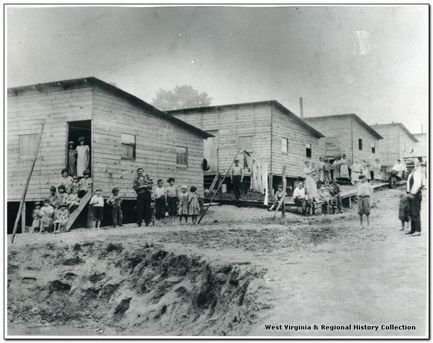 This past week has been a whirlwind of photo research for my book about Labor Organizer Fannie Sellins! I told you about sending in the final manuscript, and
my prediction that I would probably see it again.
This past week has been a whirlwind of photo research for my book about Labor Organizer Fannie Sellins! I told you about sending in the final manuscript, and
my prediction that I would probably see it again.
It came back alright, with a massive change. The editor decided not to have an artist illustrate portions of the book, but to use only photographs. I went from providing 10-12 photographs to 40!
I collected many great pictures while researching the story since 2007. The one above shows mining families in company housing, similar to those on strike in West Virginia when Fannie Sellins went to jail. She was arrested for speaking publicly about the union. Union miners had to meet secretly because it was against the law to speak about labor unions.
Some photos that look fine on the computer screen are not sufficient quality for publication. Much of the photo research process is discovering the original source to find out if a high resolution copy exists and if I can gain permission to use it.
Below are two photos not good enough for the book.
 Above: Boys who witnessed Fannie's shooting death.
Above: Boys who witnessed Fannie's shooting death. Right: Officers loaded Fannie's body in this car and drove it away.
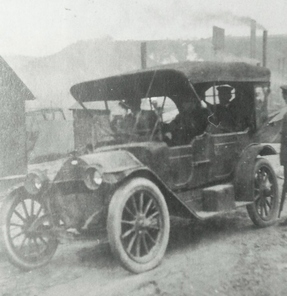 I was initially disappointed the book would not include illustrations to portray some of the critical scenes in the story of Fannie's life and death. But letting go is part of the publishing process. Erasing the vision I’ve carried in my mind for many years and being open to a whole new concept is part of the process.
I was initially disappointed the book would not include illustrations to portray some of the critical scenes in the story of Fannie's life and death. But letting go is part of the publishing process. Erasing the vision I’ve carried in my mind for many years and being open to a whole new concept is part of the process.It’s a grief process, which happens over and over again as the story goes through the hands of the editor, art director, and yes, sales and marketing. Abrams publishes amazing books (like Pure Grit ), so I trust the process will produce a book which is better than I could have imagined alone.
letting goIt’s a grief process, which happens over and over again as the story is editor, art director, and yes, sales and marketing. Abrams publishes amazing books (like Pure Grit), so I trust the process will produce a book which is better than I could have imagined alone. I found myself experiencing the necessary stages of grief--denial, anger, bargaining (yes, I tried to convince my editor to see it my way) then pain and finally acceptance. Not a big deal compared to many of the losses we suffer in life, but still important, and also, good practice.
is part of
the publishing process
In the second half of life, loss is a loyal companion. I enjoy the freedom that comes each time I practice letting go. And I look for the new opportunity that often presents itself. In this case, I’m totally psyched about the new vision for Fannie’s story. The book will be chock full of amazing historical photos, and I’m confident my words will do their job well.
I can’t always let go in a matter of days. Many losses are more difficult and acute pain cannot be avoided. I’d love to hear about your experience of letting go. Do you think it helps to practice? Can we move through difficult losses with more grace if we’ve exercised the letting-go muscle? Or am I just building up my defenses, thinking I will be able to avoid the pain of losses to come? Share your thoughts below.
Published on April 02, 2015 11:28
March 27, 2015
Going Down the Fear Highway
 "I have been through some terrible things in my life, a few of which actually happened."
"I have been through some terrible things in my life, a few of which actually happened."
Some variation of this thought is attributed to a dozen different people going back some two-thousand years to Seneca the Younger. Thomas Jefferson, Mark Twain and Dorothy Day wrote something similar.
The quote has been restated in modern times by Novelist Russell Hoban.
“When you suffer an attack of nerves you're being attacked by the nervous system. What chance has a man got against a system?”
At one time or another, we've all felt stymied, even hopeless, facing a heartless system. We can feel the same way when assaulted by our daily worries and fears. Our fear is regulated by a highly complex system in our brains, but that system is archaic, conceived in the Mesozoic era.
Can we re-figure our nervous system to better cope with modern life?
 The foundation of our fear-regulatory system is our brain-stem and cerebellum, sometimes referred to as the “reptilian brain.” It's about as savvy as the entire brain of present-day reptiles.
The foundation of our fear-regulatory system is our brain-stem and cerebellum, sometimes referred to as the “reptilian brain.” It's about as savvy as the entire brain of present-day reptiles.This part of the brain began to emerge in mammals some 200 million years ago, with the specific responsibility for survival. The reptilian brain developed the fight or flight reaction to get the job done. The system helped early life forms remain constantly alert for trouble, and aided in the important dynamic: eat breakfast, don't be eaten for breakfast.
 Over the millennia, the physical and chemical structure of our brains formed a transportation system to automatically react to threats large and small. It's a well-paved freeway with excellent signage to our destination and no speed limit.
Over the millennia, the physical and chemical structure of our brains formed a transportation system to automatically react to threats large and small. It's a well-paved freeway with excellent signage to our destination and no speed limit. Most of the threats we face on a day to day basis, do not require us to run or fight for our lives. They require a high-level system, a system that sees the reptile responses, and bypasses them for a road less traveled, a road that takes the long way around danger, through the neocortex.
The neocortex is the most recent evolution of the brain and the site of most higher brain function. Using the neocortex we can better assess danger, and not react to daily concerns and stress as though we were going be eaten for breakfast.
Take this archaic early warning system, and add to it the neuropathways we started forming in our own lifetime. As babies we responded to stressful situations such as hunger, or a wet diaper with neurons taking these same super highways in the brain. It's litte wonder we feel we don’t have a chance against the system!
You see the system not working for people when they make the same mistakes time and time again. The ruts in their brain are a well-worn track. It’s harder to notice when our own nervous system isn't working to our advantage.
Can we beI was tipped off by a wise older woman twenty years ago, to begin observing myself closely when I started to feel stressed. After practicing this observation for some time, I began to see the moment my reptilian brain leaped into action. A greater length of time later, occasionally I was able to hit the brakes and begin to bushwhack a path to the neocortex.
more present to fear?
Neuroscientists say our brains have amazing plasticity, that we’re never too old to forge a new physical and chemical structure in them.
With the presence of mind to notice the trickle of anxiety creeping over me, I am learning to relax that little lizard in my brain-stem. When I find myself worrying about what might happen, I can check out how serious the threat really is. I can ask myself it I’m heading down a track formed when I felt like a helpless child, not a capable adult. Each time I’m able to short circuit the fight/flight reaction, the road to my thinking brain gets smoother.
Each time I’m able to short circuit the fight/flight reaction, the road to my thinking brain gets smoother.I've found this a terrific way to deal with my fear of public speaking. When I get the racing heart, sweaty palms and quick breathing, I realize my body is reacting as if I'm Daniel walking into the lions den. Pausing, feeling the fear manifesting in my body, I remind myself I'm not risking my life. The audience is most likely on my side.
Recognizing and allowing fear to just be present gives me the chance to be curious when I feel that leap of adrenaline from my trusty inner lizard. Being curious, is more interesting than going down the same old road to the same old place.
What do you think? Can being more present to fear reduce stress? I'd love to hear from you.
Published on March 27, 2015 06:04
March 20, 2015
Life: Must Be Present to Win
What’s does it mean to be present to life? Sometimes it’s easier to define something by what it is not.
Probably the best example in my life—those few months when I had two in diapers and was driving my oldest to school every morning. Remembering that time, it seems like one long blur of trying to load them in the car.
 Children present in the moment, naturally. The only word in my vocabulary was hurry.
Children present in the moment, naturally. The only word in my vocabulary was hurry.
“Can you tie your shoes or should I? Okay. Hurry.”
Next came coats. When did that zipper break?
Then the trek down the driveway, to me a field of landmines, to them a range of treasure. An interesting rock, hurry. A fascinating bug, hurry. A one-a-kind leaf, hurry. Of course, we must stop to pet the neighbor’s cat, hurry.
We reach the car, but the fight has only just begun. Kids are born with an antipathy to car seats. Pick your strategy, but at some point you’ll resort to anything--bribery, brute force or giving up and staying home. Or maybe it’s my lucky day. I actually get to the buckling up. Reaching, leaning, pulling, pushing, fumbling around until you hear that click of victory, and you’re good to go. I turn the key and the engine purrs. I'm only two minutes late, which I can make up if I hit all the lights.
“Mommy.” A giggle from the backseat. “Me do it.”
I know it’s a giant step forward in child development, and my kid is at least six months ahead of the average, but there’s no joy in Mudville. He’s unbuckled his seat belt and he’s out!
Depending on the day, my young children drew me into deep presence, total lack of awareness, mostly I was somewhere in between.
Paying attention during sex- A no brainer, right? Being aware of his fingertips touching me...the changing pressure of his lips on mine. Detecting the texture of his skin. Noticing this….feeling that…you get it. After twenty-five years of marriage, could my mind drift to that library book that’s overdue? That stupid movie we watched last week? All the stuff I have to get done tomorrow? Once. Or twice. Maybe that happened. Not since my sister’s husband died last year. Her grief and loss reminds me to be more present. If my husband dies tomorrow, I want to be able to remember every second of what happened last night.
Not scarfing food- This is hard for me. I have been a scarfer all my life, so now I have a dedicated practice to increase awareness of the food I eat. Everyday for lunch, I have a salad and my paying attention begins with the sights, sounds, and feelings of washing the lettuce and cutting up the fruits and vegetables. Then I try to eat the salad mindfully, noticing taste and texture and chewing each bite thoroughly. Besides more enjoyment, chewing food longer is good for your health. Read more here….
Recognizing fear- Last, but possibly most important. Most of us learn young to deny fear, to see fear as an enemy. Fear is a natural human response to threat, real or imagined. We can hide it, ignore it, dismiss it, or minimize it—it won’t go away. Unaware, we don’t realize it underlies and motivates our actions.
Okay, I'm going long here, so I’ll pick up this subject of befriending fear next week. After all, without fear, there'd be no courage. How does being present look in your life? What's it mean to you to stop and smell the roses?
I'd love to know what you think about all this. Click comments to leave your comment below.
Probably the best example in my life—those few months when I had two in diapers and was driving my oldest to school every morning. Remembering that time, it seems like one long blur of trying to load them in the car.
 Children present in the moment, naturally. The only word in my vocabulary was hurry.
Children present in the moment, naturally. The only word in my vocabulary was hurry. “Can you tie your shoes or should I? Okay. Hurry.”
Next came coats. When did that zipper break?
Then the trek down the driveway, to me a field of landmines, to them a range of treasure. An interesting rock, hurry. A fascinating bug, hurry. A one-a-kind leaf, hurry. Of course, we must stop to pet the neighbor’s cat, hurry.
We reach the car, but the fight has only just begun. Kids are born with an antipathy to car seats. Pick your strategy, but at some point you’ll resort to anything--bribery, brute force or giving up and staying home. Or maybe it’s my lucky day. I actually get to the buckling up. Reaching, leaning, pulling, pushing, fumbling around until you hear that click of victory, and you’re good to go. I turn the key and the engine purrs. I'm only two minutes late, which I can make up if I hit all the lights.
“Mommy.” A giggle from the backseat. “Me do it.”
I know it’s a giant step forward in child development, and my kid is at least six months ahead of the average, but there’s no joy in Mudville. He’s unbuckled his seat belt and he’s out!
Depending on the day, my young children drew me into deep presence, total lack of awareness, mostly I was somewhere in between.
Here’s a few of the ways I define presence nowListening- When someone is talking to me, I am listening to them. Sounds simple. But it’s difficult if I’m thinking about what I want to say as soon as she finishes. Or if I already know what he’s going to say. Or I’ve judged the topic unimportant and I’m calculating how long she’ll go on about it. Or I’m worried and my mind is spiraling away on its twentieth rendition of what could go wrong and each detail of how wrong it could go.
Paying attention during sex- A no brainer, right? Being aware of his fingertips touching me...the changing pressure of his lips on mine. Detecting the texture of his skin. Noticing this….feeling that…you get it. After twenty-five years of marriage, could my mind drift to that library book that’s overdue? That stupid movie we watched last week? All the stuff I have to get done tomorrow? Once. Or twice. Maybe that happened. Not since my sister’s husband died last year. Her grief and loss reminds me to be more present. If my husband dies tomorrow, I want to be able to remember every second of what happened last night.
Not scarfing food- This is hard for me. I have been a scarfer all my life, so now I have a dedicated practice to increase awareness of the food I eat. Everyday for lunch, I have a salad and my paying attention begins with the sights, sounds, and feelings of washing the lettuce and cutting up the fruits and vegetables. Then I try to eat the salad mindfully, noticing taste and texture and chewing each bite thoroughly. Besides more enjoyment, chewing food longer is good for your health. Read more here….
Recognizing fear- Last, but possibly most important. Most of us learn young to deny fear, to see fear as an enemy. Fear is a natural human response to threat, real or imagined. We can hide it, ignore it, dismiss it, or minimize it—it won’t go away. Unaware, we don’t realize it underlies and motivates our actions.
Recognizing and being curious
about fear
has turned it into a positive force
in my life.
Okay, I'm going long here, so I’ll pick up this subject of befriending fear next week. After all, without fear, there'd be no courage. How does being present look in your life? What's it mean to you to stop and smell the roses?
I'd love to know what you think about all this. Click comments to leave your comment below.
Published on March 20, 2015 19:52
February 19, 2015
Life Comes Full Circle, Miracle or Human Intervention?
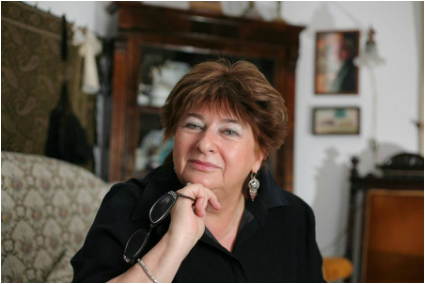 Elzbieta Ficowska Life has a way of coming full circle, sometimes in what seems a miraculous way. Take the case of Elzbieta Ficowska, an employee at a nursing home in Warsaw, Poland.
Elzbieta Ficowska Life has a way of coming full circle, sometimes in what seems a miraculous way. Take the case of Elzbieta Ficowska, an employee at a nursing home in Warsaw, Poland.You might call Elzbieta’s entire life a miracle. She was born Jewish in Nazis-occupied Poland. In hindsight, we know her chance of survival was statistically zero.
The Nazi’s forced Warsaw’s Jews, 400,000 people, nearly a third of the city’s population, into a space of sixteen blocks and barricaded them behind 7-foot walls, guarded by soldiers. Called the Warsaw Ghetto and became a holding pen for the Treblinka death camp.
Each month baby Elzbieta clung to life in the Ghetto, five thousand others perished from sickness and starvation. Anyone caught helping a Jew to escape would be shot, moreover, their entire family would be shot. In this desperate situation, that surely seemed hopeless, up sprang Zegota, the underground Polish resistance.
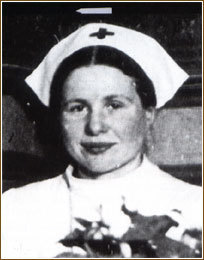 Irena Sendler One member, a young Catholic woman, code name Jolanta obtained access to the Ghetto with forged papers identifying herself as a nurse. She smuggled food, clothing and medicines to the people inside under the pretense of conducting inspections for typhus.
Irena Sendler One member, a young Catholic woman, code name Jolanta obtained access to the Ghetto with forged papers identifying herself as a nurse. She smuggled food, clothing and medicines to the people inside under the pretense of conducting inspections for typhus.In July of 1942, when Elzbiata was six months old, Jolanta came to visit with the child’s mother. There is no record of the conversation between the two young woman, but the result was that Elzbiata was drugged so that she would not cry and placed in a wooden tool box that belonged to a Gentile carpenter. He had a work pass into the Jewish section, and that day when drove his truck out through the Nazi checkpoint, his tool box with it illegal cargo lay hidden under a load of bricks.
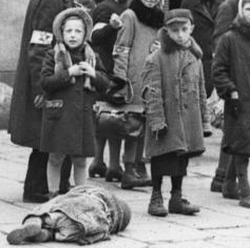 Jolanta, whose real name was Irena Sendler, organized a network of trusted friends that rescued 2,500 Polish Jewish children like Elzbiata from the Warsaw Ghetto and certain death. Irena said it was heartbreaking for the mothers to let their children go.
Jolanta, whose real name was Irena Sendler, organized a network of trusted friends that rescued 2,500 Polish Jewish children like Elzbiata from the Warsaw Ghetto and certain death. Irena said it was heartbreaking for the mothers to let their children go.“They ask if I can guarantee their safety. I have to answer no….We witnessed terrible scenes. Father agreed, but mother didn't. Sometimes they would give me their child. Other times they would say come back. I would come back a few days later and the family had already been deported. ”
Once outside the gates, the children dropped their Jewish identities and were taken to Roman Catholic Convents, orphanages and homes. Irena used every way she could imagine to get the children to safety.
Some were carried out in sacks of potatoes, some sedated in coffins, older children learned Catholic prayers and hymns and were led out through underground corridors where the Polish police had been bribed to allow their passage. Others exited under the floorboards of an ambulance, a barking dog on board to drown their cries.
Danger always lurked close by. One of the children waited by a gate in the dark, counting to 30 after the German soldier on patrol passed, then ran to the middle of the street where a manhole cover mysteriously opened and the boy escaped into the sewers to eventual freedom.
In October 1942,Elzbiata did not find out she was adopted and Jewish until her adopted mother told her when she was 17.
she telephoned
for the last time.
“She told me, much later, that my birth mother called from time to time on the telephone, and that she would ask that the telephone receiver be passed to me, at least for a moment. She undoubtedly longed for me. Perhaps she wanted to assure herself that I still existed and to hear my babbling... In October 1942, she telephoned for the last time.”
On the night of October 20 1943 the Gestapo pounded on Irena door. They took her Pawiak prison and asked her to implicate the others in her network and to give up the children’s identities. She refused, and was tortured, repeatedly, the bones in her legs and feet broken, her body scarred. Finally, she was sentenced to death. At nearly the last minute Zegota was able to bribe a German guard, who listed her as executed and left her in the woods. Irena lived in hiding until the end of the war.
At that time, she hoped to reunite the children with their families. She had kept a complete list of all 2,500 Jewish children and their new identities. She buried them in jars under a tree in a neighbor's yard across the street from the German barracks. Most of the parents, however, had been gassed at Treblinka.
 Irena Sendler Irena lived to be 98, and it was near the end of her life when she lived in a nursing home that she and Elzbieta met again.
Irena Sendler Irena lived to be 98, and it was near the end of her life when she lived in a nursing home that she and Elzbieta met again.Life coming full circle in a what may seem a miracle, but is an event that stemmed from Irena's great courage and willingness to risk her own life to help save others. Irena explained it like this, "We who were rescuing children are not some kind of heroes. That term irritates me greatly. The opposite is true – I continue to have qualms of conscience that I did so little. I could have done more. This regret will follow me to my death."
For decades, Irena lived in obscurity until a 1999 project based learning assignment at a high school in Kansas. For more about the young women who brought this heroine to the attention of the world, watch a video here...
For a two-minute video including an interview with Irena click here...
Irena learned compassion from her father who was one of the first Polish socialists and a Catholic physician. Many of his patients were poor Jews. When a typhus epidemic broke out in 1917, he was the only doctor who stayed in the area. He contracted the disease. His dying words to seven-year-old Irena were...
"If you see someone drowning, you must jump in and try to save them, even if you don't know how to swim."
Sometimes what seems miraculous is a phenomenon of human courage and compassion. I'd love to hear what you think. Please leave a comment below.
And if you think this story is worth reading, please use the icons to share it with your friends.
Published on February 19, 2015 23:05
February 15, 2015
In Memory of the Children of WWII
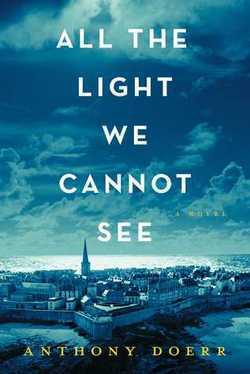 Through a stroke of luck, I heard Anthony Doerr read the first few short chapters of ALL THE LIGHT WE CANNOT SEE at a literary festival in Spokane last year. I was hooked by the specificity and beauty of his writing, and the tension of the story.
Through a stroke of luck, I heard Anthony Doerr read the first few short chapters of ALL THE LIGHT WE CANNOT SEE at a literary festival in Spokane last year. I was hooked by the specificity and beauty of his writing, and the tension of the story.Still, I put off reading the book all year while it became a finalist for the National Book Award; a #1 New York Times bestseller; was named a best book of the year by the New York Times Book Review, Powell’s Books, Barnes & Noble, NPR’s Fresh Air, Entertainment Weekly, the Washington Post, Seattle Times and the Guardian, just to name a few.
I feared a tragic ending, after all, it’s a war story. I finally overcame my trepidation, and now I highly recommend the book. It touches on all the grand themes of life that we struggle to understand.
It’s the story Marie-Laure, blind from the age of 6 who lives with her father in Paris, where he is a locksmith at the Museum of Natural History. The museum is her second home as she grows up, learning the mysteries and beauty of nature through her fingertips. She was particularly fascinated by one professors collection of shells.
 Shells at the Parisian Museum of Natural History Courtesy of Aria Antiques Dr. Geffard teaches her the names of shells--Lambis lambis, Cypraea moneta, Lophiotoma acuta--and lets her feel the spines and apertures and whorls of each in turn. He explains the branches of marine evolution and the sequences of the geologic periods; on her best days, she glimpses the limitless span of millennia behind her: millions of years, tens of millions of years.
Shells at the Parisian Museum of Natural History Courtesy of Aria Antiques Dr. Geffard teaches her the names of shells--Lambis lambis, Cypraea moneta, Lophiotoma acuta--and lets her feel the spines and apertures and whorls of each in turn. He explains the branches of marine evolution and the sequences of the geologic periods; on her best days, she glimpses the limitless span of millennia behind her: millions of years, tens of millions of years. Intertwined with the girls’ story is that of a German orphan boy Werner, incredibly bright, but trapped in a mining town that produces raw materials for the Nazi war machine. Werner is 8-years-old when he discovers a rudimentary radio in a junk heap. For three patient weeks, he studies it and works on it until he gets it to work.
Open your eyes...The only legal radio programs spout Nazi propaganda, but Werner secret listens to a Frenchman broadcast of a science lesson for children.
see what you can
with them
before they close forever
Open your eyes, concluded the man, and see what you can with them before they close forever, and then a piano comes on, playing a lonely song that sounds to Werner like a golden boat traveling a dark river, a progression of harmonies that transfigures Zollverein: the houses turned to mist, the mines filled in, the smokestacks fallen, an ancient sea spilling through the streets, and the air streaming with possibility.
It is these tenuous radio waves that eventually connect Marie-Laure and Werner, though it is years later when she is a 16-year-old working with the French Resistance and he is a soldier in the German Army using his gift for math to root out illegal radio transmitters.
 Walled city of Saint-Malo occupied by Germany in WWII
Walled city of Saint-Malo occupied by Germany in WWII Marie-Loure and her father have fled Paris for the walled city of Saint-Malo on the coast of Brittany. Throughout the book we “see” from the point-of-view of the blind girl, but here at the ocean, her perceptions become especially keen as she encounters the live creatures that were empty shells in the museum. The reader is reminded of words Werner heard over the radio years earlier.
The brain is locked in total darkness of course, children, says the voice. It floats in a clear liquid inside the skull, never in the light. And yet the world it constructs in the mind is full of light. It brims with color and movement. So how, children, does the brain, which lives without a spark of light, build for us a world full of light?
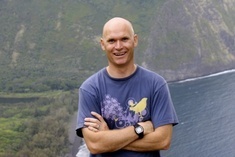 On his website,
Anthony Doerr explains the meaning of the title, All The Light We Cannot See.
On his website,
Anthony Doerr explains the meaning of the title, All The Light We Cannot See.It’s a reference first and foremost to all the light we literally cannot see: that is, the wavelengths of the electromagnetic spectrum that are beyond the ability of human eyes to detect (radio waves, of course, being the most relevant). It’s also a metaphorical suggestion that there are countless invisible stories still buried within World War II — that stories of ordinary children, for example, are a kind of light we do not typically see. Ultimately, the title is intended as a suggestion that we spend too much time focused on only a small slice of the spectrum of possibility. - from Doerr’s site
So, yes, it ends as a war story often ends, but the read is worth it. I recommend it to older teens as well as adults. The relationship between Marie-Laure and her father, and that which she develops with her great-uncle Etienne are transformative and the book is worth reading for them alone, but there is so much more that is difficult to put into words. The intricate structure crafts myriad threads together, a haunting and spectacular weaving of the highest and lowest of human nature.
Have you read it? What do you think?
With much thanks to Aria Antiques, Curious Expeditions, San Fransisco, CA
Published on February 15, 2015 11:19
February 6, 2015
Making good on post-funeral resolve
 The church filled with the beautiful, yet somber, music and chanting of In Paradisum and the pungency of incense, as the draped casket moved up the aisle from the sanctuary. I was saying good-bye to my friend Kay for the last time and my grief spilled into tears as the truth settled in my heart. She was really gone. In that instant, I didn’t think I could bear it.
The church filled with the beautiful, yet somber, music and chanting of In Paradisum and the pungency of incense, as the draped casket moved up the aisle from the sanctuary. I was saying good-bye to my friend Kay for the last time and my grief spilled into tears as the truth settled in my heart. She was really gone. In that instant, I didn’t think I could bear it.But somehow I did, and the questions rose, the same questions that niggle every funeral or memorial service—why didn’t I appreciate this person more while she was alive? Why did I take for granted her wonderful qualities, which are all we can talk about now? Why do I go through so many days not realizing how thrilling it is to be alive and the preciousness of people around me. Every time, I vow I will change. Several weeks, or maybe just days later, I’m still the same person I was before.
Maybe my goal of wholesale change is impractically dramatic. Maybe I imagine a transformation so complete it is fantasy. It’s seems so obvious that significant change is realized in small steps, but we tend to shoot for the stars without building a spaceship.
...but we tend to shoot for the stars without building a spaceship.
 I’d known Kay and her husband for more than 15-years. During that time we regularly shared the nitty-gritty of our lives and our travels on the spiritual path. Kay was lively, with a playful, sometimes irreverent sense of humor, and helped me see when I was taking myself too seriously. She was both highly-educated and wise, but paid attention to me as if at any moment I might impart some valuable knowledge.
I’d known Kay and her husband for more than 15-years. During that time we regularly shared the nitty-gritty of our lives and our travels on the spiritual path. Kay was lively, with a playful, sometimes irreverent sense of humor, and helped me see when I was taking myself too seriously. She was both highly-educated and wise, but paid attention to me as if at any moment I might impart some valuable knowledge. She was happy for me in my accomplishments large and small, and shared my disappointments and struggles. My failings fell lightly into the well of her compassion, and her capacity for accepting me without judgment set off ripples of healing. In her eyes I saw myself and I was a thing of beauty.
Kay’s ready smiles, hugs and hospitality were a well that never ran dry. I hadn’t known Kay and her husband very long, when I told my husband, “That’s the partnership I want for us when we’re 65.” They spoke to each other in tones resonant with affection, humor and mutual respect. When their eyes met, they sparkled. They shared tender glances, thoughtful conversation, and a unity of purpose. My husband and I agreed, if we didn’t begin to build this relationship now, we would not have it later.
...if we didn’t begin to build this relationship now, we would not have it later.As the years passed, we realized Kay and her husband were also teaching us how to experience the uncertainties, frailties and losses inherent in aging. They didn’t conceal their vulnerability, made no pretense of winning the fight against sickness, aging and death.
Kay was a model for me in so many ways, a mentor, a friend and an inspiration. And it was clear at her wake and funeral—I did not hold the lone lottery ticket for Kay’s love. She saw a homeless woman at the drop-in center where she volunteered with the same eyes that she saw me.
And Kay was a woman of action. What her eyes saw, she did something about, something practical, something that made tomorrow a little better than today. To understand the force for good Kay wielded in this world, requires mathematics of the heart. Take what Kay gave me, times it by every person she knew and multiply.
...requires mathematicsThe question now: Will Kay’s dying be her final lesson for me? Or can I capture some thread of her life, some texture of the woman she was, and with small, steady stitches, piece it into my daily routine. Can I continue to learn and grow through her example and help make tomorrow’s world a little better than today’s?
of the heart.
Will I have the courage to learn from love? Do you?
Published on February 06, 2015 00:00



